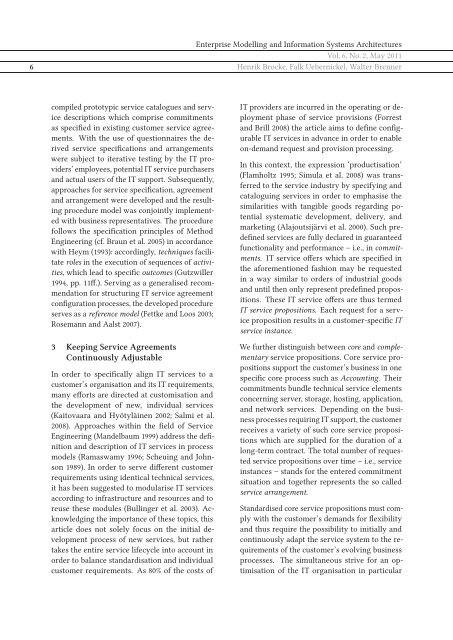Kundenorientierte Gestaltung und Vereinbarung standardisierter IT ...
Kundenorientierte Gestaltung und Vereinbarung standardisierter IT ...
Kundenorientierte Gestaltung und Vereinbarung standardisierter IT ...
Erfolgreiche ePaper selbst erstellen
Machen Sie aus Ihren PDF Publikationen ein blätterbares Flipbook mit unserer einzigartigen Google optimierten e-Paper Software.
Enterprise Modelling and Information Systems Architectures<br />
Vol. 6, No. 2, May 2011<br />
6 Henrik Brocke, Falk Uebernickel, Walter Brenner<br />
compiled prototypic service catalogues and service<br />
descriptions which comprise commitments<br />
as specified in existing customer service agreements.<br />
With the use of questionnaires the derived<br />
service specifications and arrangements<br />
were subject to iterative testing by the <strong>IT</strong> providers’<br />
employees, potential <strong>IT</strong> service purchasers<br />
and actual users of the <strong>IT</strong> support. Subsequently,<br />
approaches for service specification, agreement<br />
and arrangement were developed and the resulting<br />
procedure model was conjointly implemented<br />
with business representatives. The procedure<br />
follows the specification principles of Method<br />
Engineering (cf. Braun et al. 2005) in accordance<br />
with Heym (1993): accordingly, techniques facilitate<br />
roles in the execution of sequences of activities,<br />
which lead to specific outcomes (Gutzwiller<br />
1994, pp. 11ff.). Serving as a generalised recommendation<br />
for structuring <strong>IT</strong> service agreement<br />
configuration processes, the developed procedure<br />
serves as a reference model (Fettke and Loos 2003;<br />
Rosemann and Aalst 2007).<br />
3 Keeping Service Agreements<br />
Continuously Adjustable<br />
In order to specifically align <strong>IT</strong> services to a<br />
customer’s organisation and its <strong>IT</strong> requirements,<br />
many efforts are directed at customisation and<br />
the development of new, individual services<br />
(Kaitovaara and Hyötyläinen 2002; Salmi et al.<br />
2008). Approaches within the field of Service<br />
Engineering (Mandelbaum 1999) address the definition<br />
and description of <strong>IT</strong> services in process<br />
models (Ramaswamy 1996; Scheuing and Johnson<br />
1989). In order to serve different customer<br />
requirements using identical technical services,<br />
it has been suggested to modularise <strong>IT</strong> services<br />
according to infrastructure and resources and to<br />
reuse these modules (Bullinger et al. 2003). Acknowledging<br />
the importance of these topics, this<br />
article does not solely focus on the initial development<br />
process of new services, but rather<br />
takes the entire service lifecycle into account in<br />
order to balance standardisation and individual<br />
customer requirements. As 80% of the costs of<br />
<strong>IT</strong> providers are incurred in the operating or deployment<br />
phase of service provisions (Forrest<br />
and Brill 2008) the article aims to define configurable<br />
<strong>IT</strong> services in advance in order to enable<br />
on-demand request and provision processing.<br />
In this context, the expression ‘productisation’<br />
(Flamholtz 1995; Simula et al. 2008) was transferred<br />
to the service industry by specifying and<br />
cataloguing services in order to emphasise the<br />
similarities with tangible goods regarding potential<br />
systematic development, delivery, and<br />
marketing (Alajoutsijärvi et al. 2000). Such predefined<br />
services are fully declared in guaranteed<br />
functionality and performance – i.e., in commitments.<br />
<strong>IT</strong> service offers which are specified in<br />
the aforementioned fashion may be requested<br />
in a way similar to orders of industrial goods<br />
and until then only represent predefined propositions.<br />
These <strong>IT</strong> service offers are thus termed<br />
<strong>IT</strong> service propositions. Each request for a service<br />
proposition results in a customer-specific <strong>IT</strong><br />
service instance.<br />
We further distinguish between core and complementary<br />
service propositions. Core service propositions<br />
support the customer’s business in one<br />
specific core process such as Accounting. Their<br />
commitments b<strong>und</strong>le technical service elements<br />
concerning server, storage, hosting, application,<br />
and network services. Depending on the business<br />
processes requiring <strong>IT</strong> support, the customer<br />
receives a variety of such core service propositions<br />
which are supplied for the duration of a<br />
long-term contract. The total number of requested<br />
service propositions over time – i.e., service<br />
instances – stands for the entered commitment<br />
situation and together represents the so called<br />
service arrangement.<br />
Standardised core service propositions must comply<br />
with the customer’s demands for flexibility<br />
and thus require the possibility to initially and<br />
continuously adapt the service system to the requirements<br />
of the customer’s evolving business<br />
processes. The simultaneous strive for an optimisation<br />
of the <strong>IT</strong> organisation in particular

















